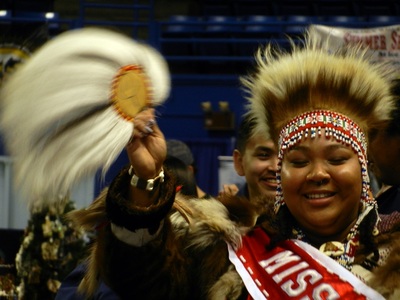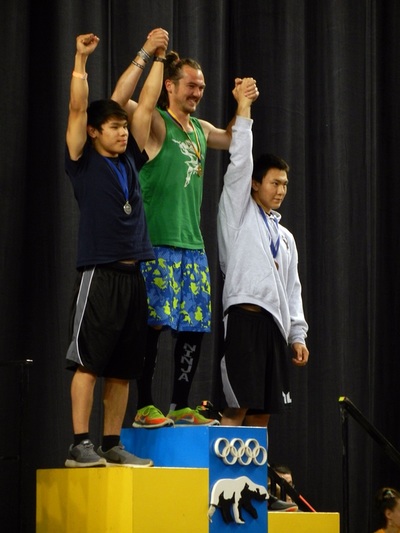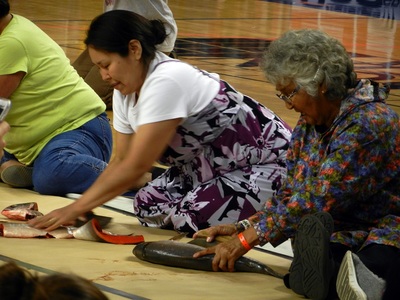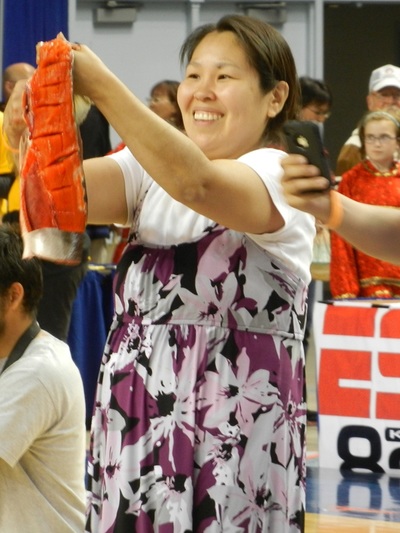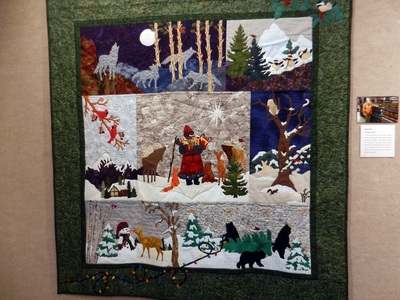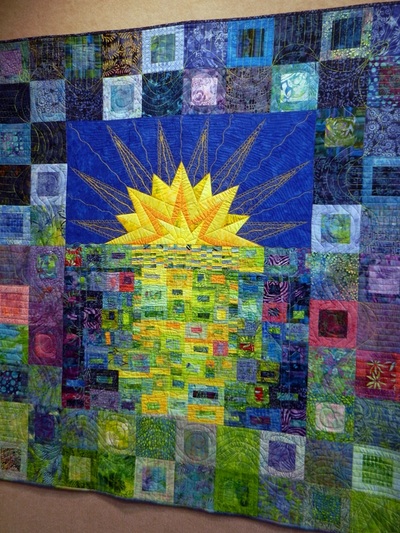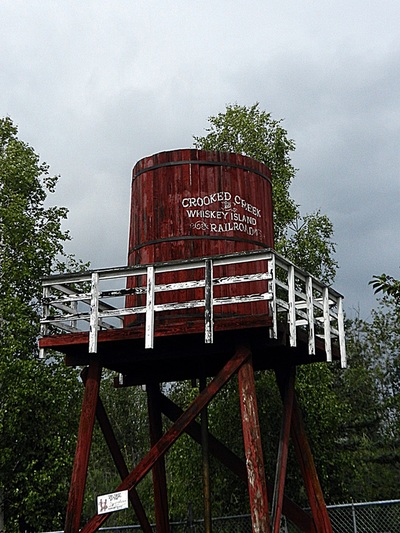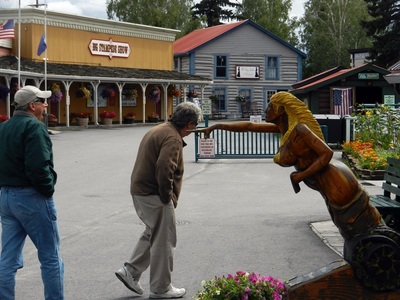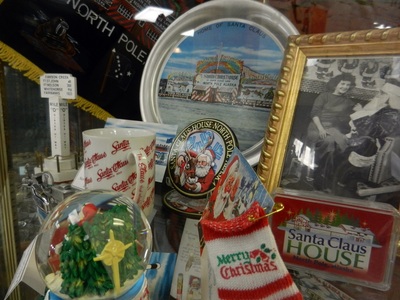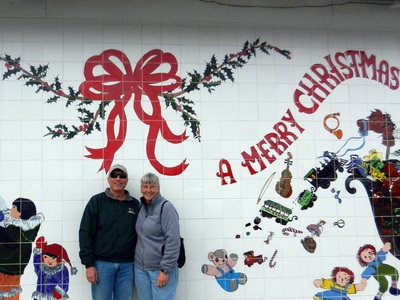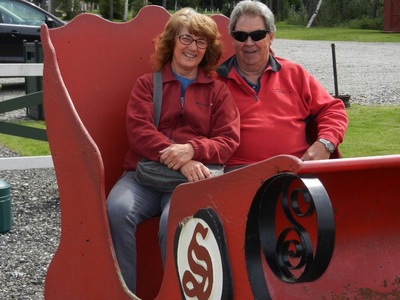 End of the Alaska Hwy at Delta Junction
End of the Alaska Hwy at Delta Junction Cruisers who make a circumnavigation of any kind have a phrase that refers to the point at which they return to their starting point. For our circumnavigation of Alaska, this happened when we entered Tok, Alaska on our way back toward Canada and the lower 48. It was the end of our Alaska visit, but not the end of our journey home. And as we left Tok, we said goodbye to Pat and Fred, who were taking the Taylor Highway up to Chicken and on to Dawson City. It wasn’t clear when we would join up again, but if not before, we would see them in Florida this November.
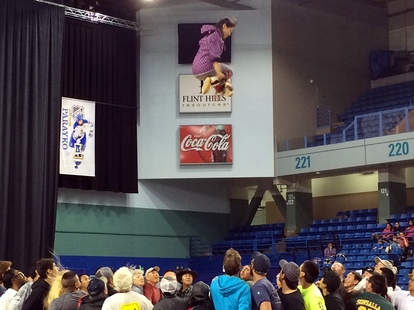 Women's blanket toss competitor
Women's blanket toss competitor A Different Kind of Olympic Games
Before leaving Fairbanks, we took in the World Eskimo-Indian Olympics (WEIO), a competition between Alaskan natives and other First Nations people in sporting events unique to their culture. Reading through the schedule beforehand, we found the names of the various competitions unusual, to say the least – Alaska Stick Pull, Kneel Jump, Ear Pull, Fish Hook, and Drop the Bomb to name a few. This was not going to be your typical track and field competition.
Before leaving Fairbanks, we took in the World Eskimo-Indian Olympics (WEIO), a competition between Alaskan natives and other First Nations people in sporting events unique to their culture. Reading through the schedule beforehand, we found the names of the various competitions unusual, to say the least – Alaska Stick Pull, Kneel Jump, Ear Pull, Fish Hook, and Drop the Bomb to name a few. This was not going to be your typical track and field competition.
 Drummers in the Opening Ceremonies
Drummers in the Opening Ceremonies Despite the unconventional games, these Olympics began like their more traditional counterpart with an Opening Ceremony, which included a parade of competitors and lighting of the Olympic flame. However, this procession was led by four dance groups who entered to the beat of their own pounding drums. And the Olympic flame being lit was a Seal Oil lamp, lit under the watchful eyes of 2 elder Lamp Tenders. The current Miss Alaska and former Miss WEIO presided over the evening’s proceedings, which included dance performances, medal ceremonies, and competitions of the Women’s Blanket Toss, the One-Hand Reach and the Fish-Cutting Contest.

Each WEIO event has historical significance as a way to build the skills necessary for the subsistence living in the arctic. Whether it’s to build strength and agility (such as the one hand reach and the Alaska high kick), hone a specific technique (such as the fish cutting or seal skinning) or increase the tolerance for pain (such as the ear pull or the fish hook), each event can be traced to activities with the Eskimo or Indian communities. We watched as the athletes contorted themselves to make the one hand reach. Then the call came out for volunteers for the blanket toss. The two of us were quick to join about 30 other volunteers that lined the four edges of a walrus skin blanket for the Women’s blanket toss. With several minutes of practice, we developed the rhythm to act together as a unit, pulling together to the Athabascan countdown of the leader. On the final count, we would all pull back and send the competitor hurtling to the rafters. The key was being in the right place to catch her when she came back down. It was exhausting, but we enjoyed being a part of the action. . However, when a similar offer was extended later to recruit additional competitors for the fish cutting contest, we politely opted out.,
 A girl performing her solo dance
A girl performing her solo dance Over the course of the night and the next day, we watched the competitions and found the feel of the crowd was as interesting as the events. The dance groups included everyone from small children to the elders. And like the blanket toss, at one point the dance performers invited everyone on to the floor. The athletes often coached their competitors, giving advice to make their reach longer or their balance better. There were two rows of special seating by the floor that were reserved for the handicapped and elders. At one point, we were offered a drink and a plate of fruit since we were also seen as elders – must be that grey hair.
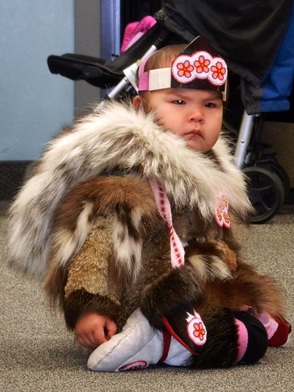 How's that for a regal stare?
How's that for a regal stare? There were also some magnificent displays of native costumes and regalia. All of the dance performers, the Miss WEIO contestants and most adorable of all the baby regalia contestants, were clothed in traditional costumes that included colorful native hooded shirts (kuspuk), fur-lined boots (muktuks), gloves, coats, and hats. But by far the most adorable were the kids. The baby regalia contestants were clothed in the most elaborate dress that showed off the maker’s skill, sometimes in spite of the little one’s discomfort at being so elegantly dressed.
Overall, the WEIO was an event we were glad we managed to be a part of, and worth the extra few days in Fairbanks to take it in. In Pat’s case, it was even more worth it, since she won the 50-50 raffle.
Overall, the WEIO was an event we were glad we managed to be a part of, and worth the extra few days in Fairbanks to take it in. In Pat’s case, it was even more worth it, since she won the 50-50 raffle.
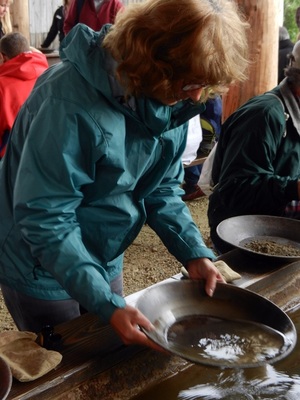 Pat hits the mother lode
Pat hits the mother lode Fairbanks - Golden Days
As much as the rest of Alaska, Fairbanks’ history is entwined with the search for gold. What started as individuals panning the streams on their individual claims evolved into sophisticated dredges that churned up the landscape in a huge noisy operation. These ceased to operate over fifty years ago, but a few have been left behind and restored enough to allow us to understand how they used to work. We learned a lot about this industry through several events focused on gold’s heyday.
As much as the rest of Alaska, Fairbanks’ history is entwined with the search for gold. What started as individuals panning the streams on their individual claims evolved into sophisticated dredges that churned up the landscape in a huge noisy operation. These ceased to operate over fifty years ago, but a few have been left behind and restored enough to allow us to understand how they used to work. We learned a lot about this industry through several events focused on gold’s heyday.
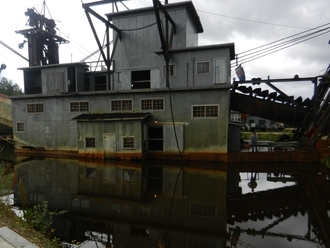 Gold Dredge #8
Gold Dredge #8 The first was a tour of Gold Dredge #8, which sits where it last was used just north of Fairbanks. Riding a train to the site of the dredge, we learned about the evolution of the mining industry and its impact on the community. Then, after a quick lesson in gold panning, we received our materials to do it for ourselves. Between the four of us, we each managed to harvest some small amount of gold. Let’s just say it’s not going to make us rich.
 Dredge buckets put to a decorative use in Pioneer Park
Dredge buckets put to a decorative use in Pioneer Park The next day, we attended a premier of a national park film about mining on Coal Creek in the Yukon-Charley National Park northeast of Tok, near the Canadian border. Using archived images, film and interviews, the movie recreated the engineering feat that was behind the first of the big dredges, that was located on Coal Creek within the boundaries of this national park.
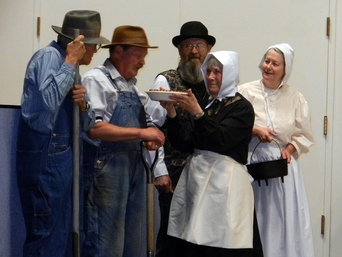 Thanksgiving among Fairbanks' Pioneers
Thanksgiving among Fairbanks' Pioneers Our last day in Fairbanks, we returned to Pioneer Park, where the first of the Golden Days festival events was being held. Golden Days celebrates Fairbanks pioneer history, and the Pioneer Club was having a flower show and tea, complete with some tongue-in-cheek skits depicting their ancestors celebrating holidays throughout the year. After the tea, we took the train ride around the park on the remnants of the Tanana Valley RR, a critical link for the few mining communities in the area.
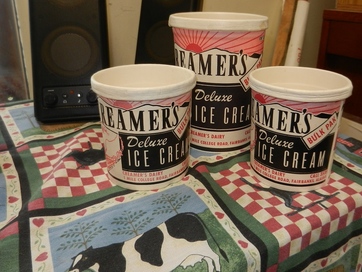 Creamer;'s Dairy Products
Creamer;'s Dairy Products When the mining industry was thriving, Fairbanks was able to support a home-grown dairy run by the aptly named Creamer family. When the economies of air freight forced an Alaska run dairy out of business, the Creamer’s closed the dairy, but convinced the local population to turn it into a wildlife refuge. Migratory birds cover the fields in the spring and fall, including trumpeter swans and sandhill cranes. We managed to meet some of the Creamer family on Creamer’s Days, when they took us on a tour of the remaining dairy buildings. They even brought their grandfather’s Chalmer’s car, which had the tradition of being the first car over every new bridge in the area. That posed an interesting dilemma, when the Veteran’s Memorial bridge opened in November of one year. The open air car was a little chilly.
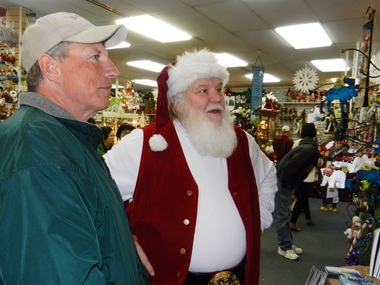 Dave and Santa at the big guy's house
Dave and Santa at the big guy's house Checking the List
We had to make a stop in North Pole before heading south to see what Santa was up to in his off season. We saw his reindeer and visited his house. Mrs. Claus was out that day, but Santa was in good form. David and Fred checked the naughty list to make sure they weren’t on it. There must be some mistake . . .
We had to make a stop in North Pole before heading south to see what Santa was up to in his off season. We saw his reindeer and visited his house. Mrs. Claus was out that day, but Santa was in good form. David and Fred checked the naughty list to make sure they weren’t on it. There must be some mistake . . .
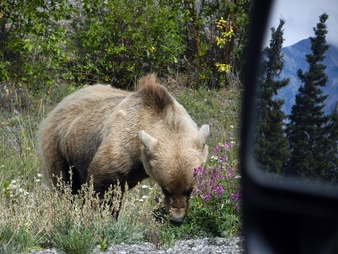 Don't mind us . . . just keep eating
Don't mind us . . . just keep eating Retracing Our Steps
So, our trip back to the lower 48 was going to take us back down the Alaska Highway for several hundred miles. We stopped to see a few things we had skipped on the way north. We took a hike in Haines Junction and visited the Village Bakery, which was an amazingly busy place for a small town. In Whitehorse, we took a stroll downtown and stumbled across music in the park, with a bluegrass band playing for a mostly hometown crowd. We were thrilled to see more big animals moving about, with moose cows and calves crossing the road in front of us a couple of times and a hungry grizzly bear grazing by the shoulder of the Alaska Highway.
So, our trip back to the lower 48 was going to take us back down the Alaska Highway for several hundred miles. We stopped to see a few things we had skipped on the way north. We took a hike in Haines Junction and visited the Village Bakery, which was an amazingly busy place for a small town. In Whitehorse, we took a stroll downtown and stumbled across music in the park, with a bluegrass band playing for a mostly hometown crowd. We were thrilled to see more big animals moving about, with moose cows and calves crossing the road in front of us a couple of times and a hungry grizzly bear grazing by the shoulder of the Alaska Highway.
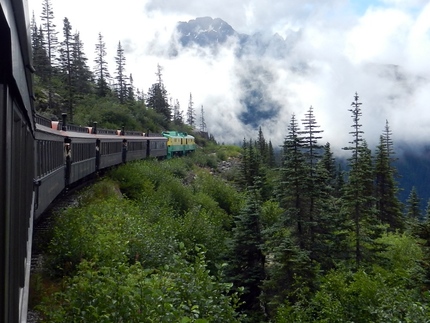 White Pass and Yukon RR en route to Skagway
White Pass and Yukon RR en route to Skagway Before heading out of Whitehorse, we took an excursion on the White Pass and Yukon Railroad over the Gold Rush route to Skagway. It was a beautiful day, and we had some beautiful scenery and dramatic drop-offs right outside the window. As we made our way east on the Alaska Highway out of Whitehorse, we stopped at the Teslin Tlingit Heritage Center, an exhibit with history and art of the local First Nation people that settled in the Yukon interior. The highlight for Dave was the bannock (afried bread) and raspberry jelly.
But our trip on the Alaska Highway ended with still another 600 miles to go. We decided to take the Cassiar Highway south just west of Watson Lake. After a side trip to fuel up, get some Canadian money and check e-mail in Watson Lake, we headed south into British Columbia.
But our trip on the Alaska Highway ended with still another 600 miles to go. We decided to take the Cassiar Highway south just west of Watson Lake. After a side trip to fuel up, get some Canadian money and check e-mail in Watson Lake, we headed south into British Columbia.
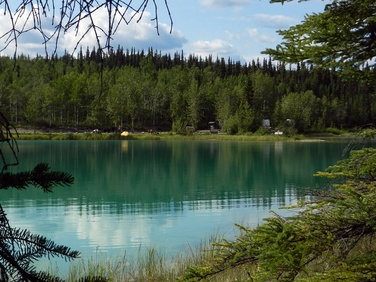 Boya Lake Provincial Park
Boya Lake Provincial Park Cassiar Highway – Boya Lake Provinical Park
The Cassiar Highway is a less-traveled highway that passes through some remote northern BC towns, many of them populated by First Nations people. The road passes through the Cassiar Mountains, passing many glacial lakes before ending on the Yellowhead Highway between Prince Rupert and Prince George. Our first day’s travel took us a short distance to Boya Lake Provincial Park. This is an absolutely beautiful emerald-green lake. We found a spot on the lake and enjoyed time hiking the trails and then two days of canoeing through the many islands and coves. The beavers are active in the crystal clear water, with lots of lodges and an impressive dam. The weather cooperated for us as well, allowing us to break out the shorts for the first time in a couple of weeks.
The Cassiar Highway is a less-traveled highway that passes through some remote northern BC towns, many of them populated by First Nations people. The road passes through the Cassiar Mountains, passing many glacial lakes before ending on the Yellowhead Highway between Prince Rupert and Prince George. Our first day’s travel took us a short distance to Boya Lake Provincial Park. This is an absolutely beautiful emerald-green lake. We found a spot on the lake and enjoyed time hiking the trails and then two days of canoeing through the many islands and coves. The beavers are active in the crystal clear water, with lots of lodges and an impressive dam. The weather cooperated for us as well, allowing us to break out the shorts for the first time in a couple of weeks.



